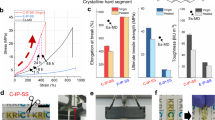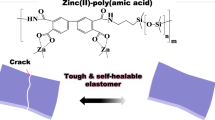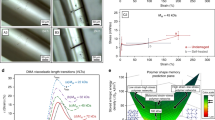Abstract
One promising application of self-healing polymeric materials is biomedical use. Although charge-transfer (CT) interactions have been employed to construct self-healing polymers as well as other reversible bonds and interactions, their potential for biomedical applications has never been investigated. In this study, we fabricated self-healable and cell-compatible polyurethane elastomers cross-linked by CT complexes between electron-rich pyrene (Py) and electron-deficient naphthalene diimide (NDI) by simply blending two linear polymers with Py or NDI as a repeating unit. The elastomers with different blend ratios self-healed damage over 1 day in mild conditions, including in air and water at 30–100 °C. The mechanical properties of damaged elastomers were almost restored after healing in air at 100 °C, and even in air at 30 °C and in water at 70 °C, healing was also possible to a certain extent. The good cell compatibility of the polyurethane elastomers was demonstrated by culturing two kinds of cells on the thin film substrates.
This is a preview of subscription content, access via your institution
Access options
Subscribe to this journal
Receive 12 print issues and online access
$259.00 per year
only $21.58 per issue
Buy this article
- Purchase on Springer Link
- Instant access to full article PDF
Prices may be subject to local taxes which are calculated during checkout







Similar content being viewed by others
References
Herbst F, Döhler D, Michael P, Binder WH. Self-healing polymers via supramolecular forces. Macromol Rapid Commun. 2013;34:203–20.
Harada A, Takashima Y, Nakahata M. Supramolecular polymeric materials via cyclodextrin–guest interactions. Acc Chem Res. 2014;47:2128–40.
Roy N, Bruchmann B, Lehn J-M. DYNAMERS: dynamic polymers as self-healing materials. Chem Soc Rev. 2015;44:3786–807.
Yang Y, Ding X, Urban MW. Chemical and physical aspects of self-healing materials. Prog Polym Sci. 2015;49-50:34–59.
Imato K, Otsuka H. Dynamic Covalent Chemistry: Principles, Reactions and Applications. In: Zhang W, Jin Y, editors. Hoboken, NJ, USA: John Wiley & Sons; 2017. p. 359–87.
Imato K, Otsuka H. Reorganizable and stimuli-responsive polymers based on dynamic carbon-carbon linkages in diarylbibenzofuranones. Polymer. 2018;137:395–413.
Dahlke J, Zechel S, Hager MD, Schubert US. How to design a self-healing polymer: general concepts of dynamic covalent bonds and their application for intrinsic healable materials. Adv Mater Interfaces. 2018;50:1800051.
Diesendruck CE, Sottos NR, Moore JS, White SR. Biomimetic self-healing. Angew Chem Int Ed. 2015;54:10428–47.
Patrick JF, Robb MJ, Sottos NR, Moore JS, White SR. Polymers with autonomous life-cycle control. Nature. 2016;540:363–70.
Levchenko I, Bazaka K, Belmonte T, Keidar M, Xu S. Advanced materials for next-generation spacecraft. Adv Mater. 2018;41:1802201.
Tu Y, Chen N, Li C, Liu H, Zhu R, Chen S, et al. Advances in injectable self-healing biomedical hydrogels. Acta Biomater. 2019;90:1–20.
Talebian S, Mehrali M, Taebnia N, Pennisi CP, Kadumudi FB, Foroughi J, et al. Self‐healing hydrogels: the next paradigm shift in tissue engineering? Adv Sci. 2019;6:1801664.
Uman S, Dhand A, Burdick JA. Recent advances in shear‐thinning and self‐healing hydrogels for biomedical applications. J Appl Polym Sci. 2019;336:48668–20.
Yanagisawa Y, Nan Y, Okuro K, Aida T. Mechanically robust, readily repairable polymers via tailored noncovalent cross-linking. Science. 2018;359:72–76.
Zhao J, Xu R, Luo G, Wu J, Xia H. Self-healing poly(siloxane-urethane) elastomers with remoldability, shape memory and biocompatibility. Polym Chem. 2016;7:7278–86.
Zhao J, Xu R, Luo G, Wu J, Xia H. A self-healing, re-moldable and biocompatible crosslinked polysiloxane elastomer. J Mater Chem B. 2016;4:982–9.
Daemi H, Rajabi-Zeleti S, Sardon H, Barikani M, Khademhosseini A, Baharvand H. A robust super-tough biodegradable elastomer engineered by supramolecular ionic interactions. Biomaterials. 2016;84:54–63.
Chen S, Bi X, Sun L, Gao J, Huang P, Fan X, et al. Poly(sebacoyl diglyceride) cross-linked by dynamic hydrogen bonds: a self-healing and functionalizable thermoplastic bioelastomer. ACS Appl Mater Interfaces. 2016;8:20591–9.
Wu Y, Wang L, Zhao X, Hou Sen, Guo B, Ma PX. Self-healing supramolecular bioelastomers with shape memory property as a multifunctional platform for biomedical applications via modular assembly. Biomaterials. 2016;104:18–31.
Liu L, Zhu L, Zhang L. A solvent-resistant and biocompatible self-healing supramolecular elastomer with tunable mechanical properties. Macromol Chem Phys. 2017;219:1700409–7.
Tallia F, Russo L, Li S, Orrin ALH, Shi X, Chen S, et al. Bouncing and 3D printable hybrids with self-healing properties. Mater Horiz. 2018;5:849–60.
Li F, Ye Q, Gao Q, Chen H, Shi SQ, Zhou W, et al. Facile fabrication of self-healable and antibacterial soy protein-based films with high mechanical strength. ACS Appl Mater Interfaces. 2019;11:16107–16.
Liu J, Duan W, Song J, Guo X, Wang Z, Shi X, et al. Self-healing hyper-cross-linked metal–organic polyhedra (HCMOPs) membranes with antimicrobial activity and highly selective separation properties. J Am Chem Soc. 2019;141:12064–70.
Zeimaran E, Pourshahrestani S, Kadri NA, Kong D, Shirazi SFS, Naveen SV, et al. Self‐healing polyester urethane supramolecular elastomers reinforced with cellulose nanocrystals for biomedical applications. Macromol Biosci. 2019;19:1900176–12.
Imato K, Yamanaka R, Nakajima H, Takeda N. Fluorescent supramolecular mechanophores based on charge-transfer interactions. Chem Commun. 2020;56:7937–40.
Cordier P, Tournilhac F, Soulié-Ziakovic C, Leibler L. Self-healing and thermoreversible rubber from supramolecular assembly. Nature. 2008;451:977–80.
Tamate R, Hashimoto K, Horii T, Hirasawa M, Li X, Shibayama M, et al. Self-healing micellar ion gels based on multiple hydrogen bonding. Adv Mater. 2018;30:1802792–7.
Burattini S, Colquhoun HM, Fox JD, Friedmann D, Greenland BW, Harris PJF, et al. A self-repairing, supramolecular polymer system: healability as a consequence of donor–acceptor π–π stacking interactions. Chem Commun. 2009;6717–9.
Burattini S, Greenland BW, Merino DH, Weng W, Seppala J, Colquhoun HM, et al. A healable supramolecular polymer blend based on aromatic π−π stacking and hydrogen-bonding interactions. J Am Chem Soc. 2010;132:12051–8.
Fox J, Wie JJ, Greenland BW, Burattini S, Hayes W, Colquhoun HM, et al. High-strength, healable, supramolecular polymer nanocomposites. J Am Chem Soc. 2012;134:5362–8.
Hart LR, Harries JL, Greenland BW, Colquhoun HM, Hayes W. Supramolecular approach to new inkjet printing inks. ACS Appl Mater Interfaces. 2015;7:8906–14.
Hart LR, Nguyen NA, Harries JL, Mackay ME, Colquhoun HM, Hayes W. Perylene as an electron-rich moiety in healable, complementary π-π stacked, supramolecular polymer systems. Polymer. 2015;69:293–300.
Qin J, Lin F, Hubble D, Wang Y, Li Y, Murphy IA, et al. Tuning self-healing properties of stiff, ion-conductive polymers. J Mater Chem A. 2019;7:6773–83.
Xiao W-X, Liu D, Fan C-J, Xiao Y, Yang K-K, Wang Y-Z. A high-strength and healable shape memory supramolecular polymer based on pyrene-naphthalene diimide complexes. Polymer. 2020;190:122228.
Imato K, Takahara A, Otsuka H. Self-healing of a cross-linked polymer with dynamic covalent linkages at mild temperature and evaluation at macroscopic and molecular levels. Macromolecules. 2015;48:5632–9.
Imato K, Natterodt JC, Sapkota J, Goseki R, Weder C, Takahara A, et al. Dynamic covalent diarylbibenzofuranone-modified nanocellulose: mechanochromic behaviour and application in self-healing polymer composites. Polym Chem. 2017;8:2115–22.
Kim S-M, Jeon H, Shin S-H, Park S-A, Jegal J, Hwang SY, et al. Superior toughness and fast self-healing at room temperature engineered by transparent elastomers. Adv Mater. 2018;30:1705145–8.
Zhang L, Liu Z, Wu X, Guan Q, Chen S, Sun L, et al. A highly efficient self-healing elastomer with unprecedented mechanical properties. Adv Mater. 2019;31:1901402–8.
Hornat CC, Urban MW. Entropy and interfacial energy driven self-healable polymers. Nat Commun. 2020;11:1028.
Gunatillake PA, Adhikari R, Gadegaard N. Biodegradable synthetic polymers for tissue engineering. Eur Cells Mater. 2003;5:1–16.
Teo AJT, Mishra A, Park I, Kim Y-J, Park WT, Yoon YJ. Polymeric biomaterials for medical implants and devices. ACS Biomater Sci Eng. 2016;2:454–72.
Imato K, Nishihara M, Kanehara T, Amamoto Y, Takahara A, Otsuka H. Self-healing of chemical gels cross-linked by diarylbibenzofuranone-based trigger-free dynamic covalent bonds at room temperature. Angew Chem Int Ed. 2012;51:1138–42.
Imato K, Ohishi T, Nishihara M, Takahara A, Otsuka H. Network reorganization of dynamic covalent polymer gels with exchangeable diarylbibenzofuranone at ambient temperature. J Am Chem Soc. 2014;136:11839–45.
Imato K, Irie A, Kosuge T, Ohishi T, Nishihara M, Takahara A, et al. Mechanophores with a reversible radical system and freezing-induced mechanochemistry in polymer solutions and gels. Angew Chem Int Ed. 2015;54:6168–72.
Imato K, Kanehara T, Nojima S, Ohishi T, Higaki Y, Takahara A, et al. Repeatable mechanochemical activation of dynamic covalent bonds in thermoplastic elastomers. Chem Commun. 2016;52:10482–5.
Sun TL, Kurokawa T, Kuroda S, Ihsan AB, Akasaki T, Sato K, et al. Physical hydrogels composed of polyampholytes demonstrate high toughness and viscoelasticity. Nat Mater. 2013;12:932–7.
Nakahata M, Takashima Y, Harada A. Highly flexible, tough, and self-healing supramolecular polymeric materials using host-guest interaction. Macromol Rapid Commun. 2016;37:86–92.
He D, Arisaka Y, Masuda K, Yamamoto M, Takeda N. A photoresponsive soft interface reversibly controls wettability and cell adhesion by conformational changes in a spiropyran-conjugated amphiphilic block copolymer. Acta Biomater. 2017;51:101–11.
Tamada Y, Yoshito I. Effect of preadsorbed proteins on cell adhesion to polymer surfaces. J Colloid Interface Sci. 1993;155:334–9.
Li Y, Xiao Y, Liu C. The Horizon of Materiobiology: A perspective on material-guided cell behaviors and tissue engineering. Chem Rev. 2017;117:4376–421.
Acknowledgements
This work was supported by JSPS KAKENHI (Grant No. 16H07292 and 19K15623, KI), MEXT LEADER (Grant No. A6501, KI), and the Izumi Science and Technology Foundation (Grant No. H29-J-113, KI). A research grant from the Mitsubishi Materials–Faculty of Science and Engineering, Waseda University (2016, 2018) and a Grant for Young Scientists Encouragement from the Waseda Research Institute for Science and Engineering–JXTG Energy (2017) are also acknowledged for financial support.
Author information
Authors and Affiliations
Corresponding authors
Ethics declarations
Conflict of interest
The authors declare that they have no conflict of interest.
Additional information
Publisher’s note Springer Nature remains neutral with regard to jurisdictional claims in published maps and institutional affiliations.
Supplementary information
Rights and permissions
About this article
Cite this article
Imato, K., Nakajima, H., Yamanaka, R. et al. Self-healing polyurethane elastomers based on charge-transfer interactions for biomedical applications. Polym J 53, 355–362 (2021). https://doi.org/10.1038/s41428-020-00432-4
Received:
Revised:
Accepted:
Published:
Issue Date:
DOI: https://doi.org/10.1038/s41428-020-00432-4



